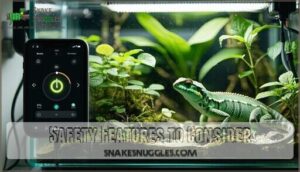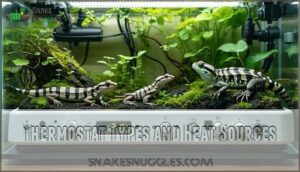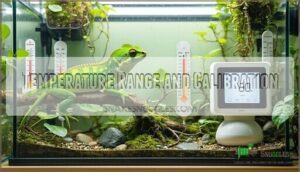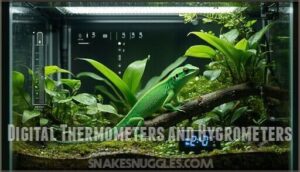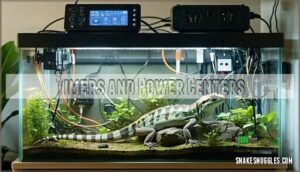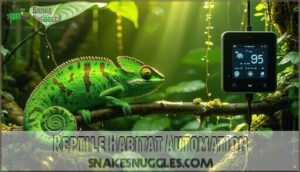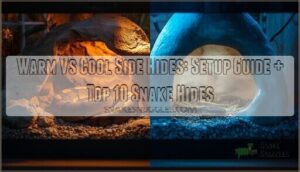This site is supported by our readers. We may earn a commission, at no cost to you, if you purchase through links.
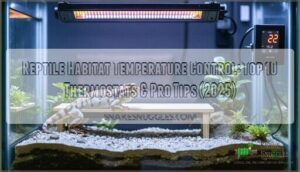
Reptile habitat temperature control is essential for their health and well-being.
You’ll want to invest in a reliable thermostat that can maintain a precise temperature range with a thermal gradient. Look for features like temperature calibration, safety shut-off, and compatibility with various heat sources.
Don’t worry, our expert guidance will help you – our top 10 thermostat picks and pro tips will help you master reptile habitat temperature control. Get ready to create a temperature haven for your scaly pals!
Table Of Contents
- Key Takeaways
- Reptile Temperature Control Basics
- Choosing Right Thermostat
- Top 10 Reptile Thermostats
- 1. Inkbird ITC308 Digital Temperature Controller
- 2. WILLHI WH1436A Digital Temperature Controller
- 3. VIVOSUN Digital Heat Mat Controller
- 4. bayite Dual Stage Temperature Controller
- 5. Inkbird Heat Mat Temperature Controller
- 6. Hydrofarm Heat Mat Thermostat Controller
- 7. Inkbird WiFi Temperature Controller Thermostat
- 8. Inkbird ITC 608T Temperature Humidity Controller
- 9. Zoo Med Digital Reptile Thermostat
- 10. Digital Heat Mat Thermostat Controller
- Advanced Temperature Control Methods
- Reptile Habitat Automation
- Frequently Asked Questions (FAQs)
- What is the best temperature control method for a pet reptile?
- How do reptiles thermoregulate?
- Do Reptiles need Heat mats and cables?
- Why do Reptiles need a temperature controller?
- What are reptile thermostats & thermometers?
- Do Reptiles need a terrarium thermostat?
- How to regulate temperature in reptile enclosure?
- What temperature should a reptile habitat be?
- What is the difference between a thermostat and a temperature controller?
- How often replace thermostat probes?
- Conclusion
Key Takeaways
- You’ll want to invest in a reliable thermostat that can maintain a precise temperature range with a thermal gradient, and look for features like temperature calibration, safety shut-off, and compatibility with various heat sources to ensure your reptile’s health and well-being.
- It’s crucial to understand the basics of thermostats and temperature gradients to create a safe and comfortable home for your reptile, and to consider the importance of precise temperature regulation, which can affect your reptile’s health and behavior.
- You should choose a thermostat that matches your reptile’s species needs and your setup’s complexity, and consider safety features like overheat protection, short-circuit prevention, and alarm systems to keep your pet safe and your mind at ease.
- To regulate temperature in your reptile enclosure, you’ll want to use a reliable thermostat, maintain a thermal gradient by placing heat sources at one end, and monitor temperature levels regularly to ensure a stable and healthy environment for your reptile, and don’t forget to replace thermostat probes every 6-12 months or when damaged to prevent inaccurate temperature readings.
Reptile Temperature Control Basics
You’ll need to control your reptile’s habitat temperature with precision, since even small changes can affect their health and behavior.
Precise temperature control is key to your reptile’s health and happiness.
Understanding the basics of thermostats and temperature gradients helps you create a safe, comfortable home—no one wants a grumpy gecko or a sluggish snake.
Importance of Precise Temperature Regulation
Think of temperature regulation as your reptile’s invisible bodyguard. Without it, you risk health complications and sluggish activity levels.
Temperature regulation is your reptile’s ultimate protector
Here’s why reptile habitat temperature control matters:
- Prevents temperature fluctuations that harm reptile health.
- Supports digestion and provides an immunity boost.
- Maintains thermal gradients, so your pet can bask or cool off as needed—no cold-blooded drama!
Types of Reptile Thermostats
Once you understand why temperature matters, it’s time to pick the right thermostat type.
On/Off Thermostats work like a light switch—simple and reliable. Pulse proportional thermostats send tiny bursts of power for steady warmth. Dimming thermostats smoothly adjust heat, perfect for bulbs.
Digital thermostats offer precision, while Environmental Control systems automate everything. Choose a reptile thermostat that matches your setup, considering the importance of temperature control.
Features of Reptile Thermostats
Ever wonder what sets a good reptile thermostat apart?
Focus on thermostat accuracy, safety mechanisms like alarms, and control types—on/off, dimming, or pulse proportional thermostat.
Power capacity matters; you don’t want to blow a fuse.
Probe placement is key for reliable readings.
Digital thermostats offer easy monitoring.
Proper thermoregulation is essential for habitat stability.
Prioritize thermostat features that match your reptile’s needs and reptile’s habitat.
Choosing Right Thermostat
When you’re picking a thermostat for your reptile’s home, you need to match the device to your pet’s needs and your setup’s complexity, just like choosing the right shoes for a long hike.
Don’t worry, you won’t need an engineering degree, but you’ll want to check for safety features, temperature range, and compatibility with your heat source to keep your scaly friend happy and healthy.
Safety Features to Consider
After learning the basics, let’s talk safety features every reptile thermostat should have.
You don’t want surprises—unless it’s your gecko’s dinner dance.
Look for:
- Overheat Protection
- Short-Circuit Prevention
- Alarm Systems for temperature spikes
- ETL Approval for electrical safety
- Accurate Probe Placement for true temperature readings
These features keep your pet safe and your mind at ease.
Thermostat Types and Heat Sources
Once you’ve checked safety features, match your reptile thermostat to the right heat source.
On/Off Thermostats work well with heat mats and ceramic heaters, while Dimming Thermostats are best for a reptile heat lamp or deep heat projector.
Pulse Proportional models offer steady control for most setups.
For precise temperature management, consider a digital thermostat controller.
Always check power requirements so your reptile heating stays safe and reliable.
Temperature Range and Calibration
Once you’ve matched thermostat type to your heat source, focus on temperature range and calibration.
Every reptile has unique species temperature needs, so dial in thermostat accuracy and temperature calibration for safety.
Keep a close eye on gradient monitoring, especially when making seasonal adjustments.
Don’t let guesswork rule—rely on:
- Regular thermostat calibration checks
- Monitoring temperature range accuracy
- Adjusting for seasonal shifts
Top 10 Reptile Thermostats
You need a reliable thermostat to keep your reptile’s habitat at the perfect temperature, because nobody wants a lizard with cold feet.
Here are the top 10 reptile thermostats for 2025, each designed to help you create a safe, stable environment for your scaly friend.
1. Inkbird ITC308 Digital Temperature Controller
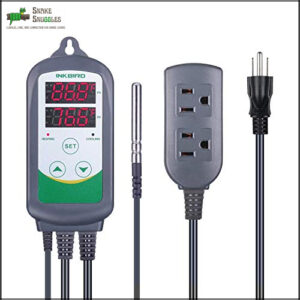
If you want reliable, hands-off temperature control, the Inkbird ITC308 is a standout choice.
It handles both heating and cooling, with a temperature span from -58°F to 248°F—perfect for most reptile enclosures.
The LED display is easy to read, and calibration keeps things accurate. You might fumble with the Celsius default at first, but YouTube tutorials make setup a breeze.
It’s durable, straightforward, and trusted by many.
Best For: People who need precise, hands-off temperature regulation for projects like homebrewing, greenhouses, or reptile enclosures.
- Plug-and-play design supports both heating and cooling devices
- Highly accurate with easy-to-read LED display and calibration feature
- Durable and reliable for indoor or outdoor use
- Instruction manual can be confusing, especially for beginners
- Default temperature unit is Celsius, requiring manual change to Fahrenheit
- Symbols used for settings and indicators are not intuitive
2. WILLHI WH1436A Digital Temperature Controller
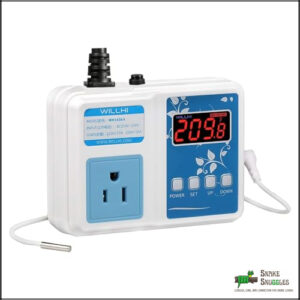
You’ll rarely find a thermostat as flexible as the WILLHI WH1436A Digital Temperature Controller.
It swings both ways, literally—handling heating and cooling modes—so your reptile stays comfortable, come heatwave or cold snap.
With a wide range from -58°F to 230°F and a 9.8-foot waterproof probe, it’s great for awkward or humid setups.
It doesn’t do Wi-Fi, but that’s actually a plus: plug it in, set it up, and let it quietly babysit, keeping things reliably safe and steady.
Best For: Hands-on reptile keepers, home brewers, and anyone needing a flexible, plug-and-play temp controller without Wi-Fi hassles.
- Supports both heating and cooling for a wide range of habitats and uses.
- Accurate to 0.1°F/°C, with easy calibration and a long waterproof sensor cable.
- Stores settings after power loss and offers reliable, silent operation.
- Not suitable for high-wattage devices above 1100W/10A.
- Bright display light may be distracting in dark rooms.
- No remote monitoring or Wi-Fi connectivity.
3. VIVOSUN Digital Heat Mat Controller
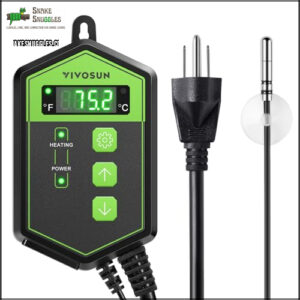
The VIVOSUN Digital Heat Mat Controller offers budget-friendly temperature control for reptile habitats.
You’ll maintain temperatures between 40-108°F with decent accuracy, though expect 4-5°F fluctuations rather than the precision of pricier models.
Its hexagonal design includes hanging tabs and wall mounts for easy installation.
The dual digital display shows real-time temperatures, and simple button controls let you adjust settings quickly.
While it’s one of the cheapest thermostats available, it delivers reliable results for basic heat mat regulation in reptile enclosures.
Best For: Reptile enthusiasts and hobbyists who need a budget-friendly temperature control solution for their habitats.
- Offers reliable temperature regulation for heat mats in reptile enclosures
- Easy to install and use, with a simple and compact design
- Affordable price point compared to other thermostats on the market
- Temperature fluctuations of 4-5°F may not be suitable for all applications
- Overall quality is somewhat lower than similar reptile thermostats
- Some users have reported minor drawbacks, including unit malfunctions and initial setup confusion
4. bayite Dual Stage Temperature Controller
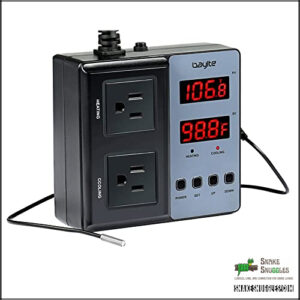
When you need dual-stage control, the bayite BTC201 delivers professional-grade precision for demanding reptile setups.
This powerhouse controller manages both heating and cooling simultaneously through dual relay outputs, handling up to 1100W of equipment.
You’ll appreciate the dual display showing real-time and set temperatures at once, plus built-in safety features like temperature alarms and compressor delay protection.
Proper setup guarantees habitat stability needs are met.
The waterproof 9.8-foot probe ensures accurate readings even in humid environments.
Perfect for complex habitats requiring tight temperature control.
Best For: Advanced users needing reliable dual-stage temperature control for reptile habitats, aquariums, greenhouses, or home-brew setups.
- Simultaneously controls heating and cooling with dual relays for precise temperature management.
- Dual display windows show real-time and set temperatures, making monitoring easy.
- Safety features include high/low temperature alarms, waterproof probe, and compressor delay protection.
- Not waterproof, so it must be protected from splashes or drips during use.
- Manual calibration may be required for accurate temperature readings.
- Can be complex and technical to set up for first-time users.
5. Inkbird Heat Mat Temperature Controller
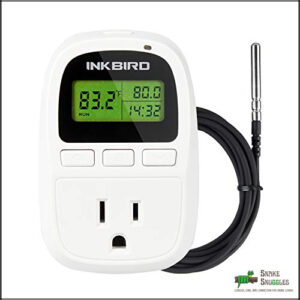
When your reptile’s warmth depends on timely precision, the Inkbird Heat Mat Temperature Controller stands out.
It handles temperatures from -58°F to 212°F, making it perfect for snug terrariums and finicky critters.
With clear digital displays and easy controls, you’ll set basking spots with confidence—no guesswork, no wild swings.
Its waterproof probe laughs at spills, and you’ll find it just as handy for seedling mats or DIY heat boxes.
For peace of mind, double-check current loads—safety always comes first.
Best For: Reptile keepers and DIYers who need reliable, precise temperature control for sensitive environments.
- Wide temperature range supports reptile enclosures, seedling mats, and pest control projects.
- Digital controls and waterproof probe make it easy to use and maintain.
- Adjustable day/night settings and clear display reduce guesswork.
- Maximum load (1500W) may pose risks if paired with high-powered space heaters.
- Some users report confusing instructions and calibration can be required.
- Units may arrive in less-than-new condition, impacting first impressions.
6. Hydrofarm Heat Mat Thermostat Controller
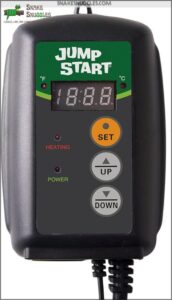
You’re considering the Hydrofarm Heat Mat Thermostat Controller, a reliable option.
It offers universal compatibility, a temperature range of 68°F to 108°F, and ETL certification for safety.
With its digital controller and 6-foot water-resistant probe, you can trust it for precise temperature control in your reptile habitat, ensuring a stable environment for your pets.
Best For: reptile keepers, homebrewers, and gardeners who need precise temperature control for their projects or pets.
- Lacks built-in timer or alarm features
- The controller is not submersible, so it must be kept dry
- Requires proper placement of the temperature probe for accurate readings
- Offers universal compatibility with all Hydrofarm heat mats and various applications
- Provides a temperature range of 68°F to 108°F and ETL certification for safety
- Features a digital controller and 6-foot water-resistant probe for precise temperature control
7. Inkbird WiFi Temperature Controller Thermostat
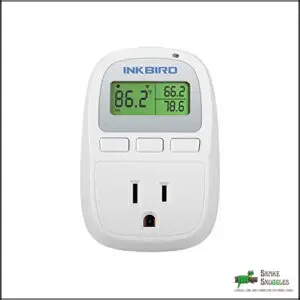
With the Inkbird WiFi Temperature Controller Thermostat, you’re in the driver’s seat of your reptile’s habitat.
This smart device lets you remotely monitor and adjust temperatures via the InkbirdSmart app, ensuring your scaly friend stays comfortable. Set temperature limits, receive alarm notifications, and enjoy the convenience of voice control through Alexa.
Plus, the compact design and simple setup make it a breeze to integrate into your existing setup. Say goodbye to temperature tantrums and hello to a happy, healthy reptile with the Inkbird WiFi Temperature Controller Thermostat and its voice control through Alexa, all while staying in the driver’s seat of your reptile’s habitat.
Best For: reptile owners, greenhouse managers, and anyone who needs to maintain a stable temperature in their environment.
- Remotely monitor and adjust temperatures via the InkbirdSmart app
- Compatible with Alexa for voice-controlled temperature adjustments
- Compact design and simple setup for easy integration into existing setups
- Some units have failed after a few months of use
- Limited smart features in the iOS app compared to other Inkbird models
- Issues with Amazon Alexa integration, including incorrect temperature reporting
8. Inkbird ITC 608T Temperature Humidity Controller
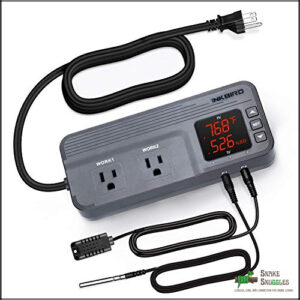
You’re looking for a reliable temperature and humidity controller for your reptile habitat.
The Inkbird ITC 608T is a top choice, offering dual relay outputs for independent control of heating and humidifying devices.
With a temperature control range of -50°C to 99°C and humidity control range of 10% to 99% RH, this controller provides precise environmental control.
Its LCD display and adjustable set points make it easy to monitor and adjust conditions, ensuring a safe and healthy environment for your reptiles.
Best For: Reptile keepers and enthusiasts who need a reliable and precise temperature and humidity controller for their habitats.
- Offers dual control of temperature and humidity in a single unit, making it a convenient and space-saving solution.
- Provides accurate and repeatable performance in various applications, ensuring a safe and healthy environment for reptiles.
- Has a high humidity range (85-98%) without sensor pegging out, making it suitable for a wide range of reptile species.
- Has limited functionality when controlling both temperature and humidity simultaneously, requiring careful programming to achieve desired outcomes.
- The instructions and display symbols can be confusing, making it difficult for some users to set up and use the device.
- Does not have a waterproof temperature probe option available, which may limit its use in certain applications.
9. Zoo Med Digital Reptile Thermostat
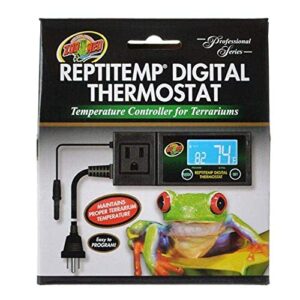
Often considered the gold standard for reptile keepers, Zoo Med’s ReptiTemp RT-600 delivers reliable temperature control from 50°F to 122°F.
You’ll appreciate its dual-mode operation that handles both heating and cooling devices up to 600 watts.
The 6-foot remote sensor cable gives you flexible placement options, while built-in memory saves your settings during power outages.
Its LCD display shows current and set temperatures clearly, plus you get audio-visual alarms for extreme conditions.
Though the bright backlight can’t be disabled, this affordable thermostat consistently maintains accurate temperatures within 1-2°F.
Best For: Reptile keepers seeking reliable, accurate temperature control for terrariums and enclosures with flexible heating and cooling options.
- Single power outlet limits simultaneous control of multiple devices
- Bright backlight cannot be disabled, potentially requiring covering in dark environments
- Bulky design due to front-facing power cord plug affects placement options
- Dual-mode operation controls both heating (600W) and cooling (150W) devices with precise temperature management
- Built-in memory retains settings during power failures, plus audio-visual alarms for extreme temperature conditions
- 6-foot remote sensor cable allows flexible placement with accurate readings within 1-2°F
10. Digital Heat Mat Thermostat Controller
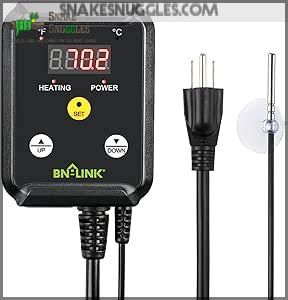
Perfect for beginners, this budget-friendly controller offers straightforward temperature management between 68-108°F.
You’ll appreciate its simple three-button setup and clear digital display that shows both current and target temperatures.
The 4.92-foot probe guarantees accurate readings when placed correctly in your reptile’s habitat.
With ETL certification and a maximum 1000W capacity, it’s reliable for most heat mats and ceramic emitters.
While it lacks advanced features like WiFi connectivity, it delivers consistent performance that’s made it a favorite among reptile keepers for years, offering straightforward temperature management and a simple three-button setup.
Best For: Beginners or hobbyists who need a simple, reliable thermostat for reptile enclosures or seedling heat mats.
- No advanced features like WiFi or smartphone connectivity.
- Not recommended for incubators due to potential temperature fluctuations.
- Functionality limited to heating only, no cooling control.
- Easy three-button setup, ideal for users new to temperature controllers.
- Clear, bright digital display shows both current and set temperatures.
- ETL certified and supports up to 1000W for a wide range of heating devices.
Advanced Temperature Control Methods
Once you’ve chosen your thermostat, you’ll need supporting equipment to create the perfect reptile habitat.
Advanced temperature control methods include digital thermometers for precise monitoring, automated timers for day-night cycles, and environmental control systems that manage your entire setup, utilizing digital thermometers.
Digital Thermometers and Hygrometers
Beyond selecting the right thermostat, you’ll need precise monitoring tools to maintain ideal conditions.
Digital thermometers and hygrometers work alongside your thermostat to create thorough environmental control. Accuracy calibration guarantees your reptile thermometer readings match actual conditions, while proper probe placement prevents false readings that could endanger your pet.
Key monitoring essentials:
- Data logging tracks temperature patterns over time, revealing dangerous fluctuations
- Remote monitoring lets you check conditions from anywhere, preventing disasters
- Alarm systems alert you instantly when temperatures drift outside safe ranges
Modern digital thermometer and hygrometer combinations offer wireless connectivity, allowing smartphone alerts when your gecko’s habitat drops below 75°F overnight.
Proper setup involves safe heat element placement to prevent burns.
Timers and Power Centers
Timers and power centers streamline your reptile habitat management by automating lighting and heating cycles.
These digital timer systems eliminate guesswork while maintaining consistent environmental conditions. You’ll reduce energy costs and prevent disruptions from power outages or human error.
| Feature | Digital Timer | Power Center | Night Drop Module |
|---|---|---|---|
| Automated Schedules | Yes | Yes | Yes |
| Multiple Devices | 1-2 | 4-8 | 1-2 |
| Timer Accuracy | ±1 minute | ±30 seconds | ±1 minute |
| Energy Efficiency | Moderate | High | High |
Heating and Cooling Devices
Your reptile heat lamp works alongside cooling devices to create the perfect thermal environment.
While a reptile heat mat provides belly warmth, you’ll need additional tools for temperature control. Proper temperature control is essential for reptile health.
Here are three key device categories:
- Heating devices – Ceramic heat emitters, basking lamp types, and heat mats offer targeted warmth
- Cooling devices – Cooling fan efficiency and misting system benefits help prevent overheating
- Safety features – Heat mat safety mechanisms protect your pet from burns
Environmental Control Systems
Complete system integration transforms your reptile enclosure into a smart habitat. These environmental control systems manage reptile temperature, humidity, and lighting simultaneously through remote access capabilities.
Future trends include AI-powered emergency protocols that automatically adjust conditions. Energy efficiency features reduce costs while maintaining ideal reptile temperature control.
Advanced systems create seamless microclimates for your pet’s comfort, ensuring a well-regulated environment that is both efficient and energy efficient.
Reptile Habitat Automation
You can turn your reptile habitat into a smart ecosystem that runs itself with minimal daily intervention.
Modern automation systems control lighting cycles, temperature gradients, and humidity levels simultaneously, freeing you to focus on your pet’s health rather than constantly adjusting dials, which allows for a more efficient and healthy environment.
Automating Lighting and Heating
Why struggle with manual temperature adjustments when automated schedules can handle everything?
Smart thermostats with remote control capabilities let you program day-night cycles that mirror natural patterns.
Power centers equipped with energy efficiency features automatically coordinate reptile lighting and heat lamps based on your thermostat settings.
This reptile habitat temperature control system eliminates guesswork while maintaining ideal temperatures around the clock, utilizing energy efficiency features.
Humidity Control and Monitoring
You can’t overstate humidity importance—it’s the secret sauce behind smooth sheds and healthy skin.
To nail reptile humidity, use a quality hygrometer and check it often (hygrometer calibration matters!).
Misting systems and humidity substrates really help keep your pets comfy. A great place to find a reptile humidity reader is online.
- Watch for stuck sheds—a sign humidity’s off
- Place a humidity sensor in the basking area
- Use daily mistings to adjust levels
Creating Thermal Gradients
When designing your reptile’s habitat, consider creating a thermal gradient, including a basking spot and cool zone, to meet species needs.
Proper probe placement guarantees a suitable temperature gradient, allowing your pet to regulate its body temperature effectively, which is vital for its overall health and well-being always.
Precise temperature regulation prevents health complications.
This is why temperature control matters, and it is essential for maintaining the overall health of your reptile.
Researching Native Environment Conditions
You’ll often research native environment conditions to replicate your reptile’s natural habitat.
- Desert species need high temperatures
- Rainforest species prefer humidity
- Temperate species require moderate temperatures
Understanding habitat temperature ranges helps create a dynamic thermal landscape for your reptile species, which is crucial for replicating their natural environment.
Frequently Asked Questions (FAQs)
What is the best temperature control method for a pet reptile?
For the best temperature control, invest in a digital thermostat with a temperature range suitable for your pet reptile’s species.
Consider a model with safety features like overheat protection and alarms.
How do reptiles thermoregulate?
You help reptiles thermoregulate by providing external heat sources, as they’re ectothermic, relying on environment to regulate body temperature, unlike humans who generate heat internally.
Do Reptiles need Heat mats and cables?
You’re the conductor of your reptile’s orchestra, and heat mats and cables can be essential instruments, providing warmth and comfort for your pet’s well-being, depending on their species’ needs.
Why do Reptiles need a temperature controller?
You need a temperature controller to regulate your reptile’s environment, ensuring their health and survival by maintaining ideal temperatures.
What are reptile thermostats & thermometers?
Reptile thermostats & thermometers are devices that help you regulate and monitor the temperature in your pet’s enclosure.
They ensure a safe and healthy environment by maintaining ideal temperature ranges and preventing overheating or underheating, which is crucial for the pet’s well-being, especially in terms of temperature.
Do Reptiles need a terrarium thermostat?
Like a master chef, you regulate their environment, and yes, you’ll want a terrarium thermostat to cook up a perfect climate for your scaly friends’ health and happiness.
How to regulate temperature in reptile enclosure?
To regulate temperature in your reptile enclosure, use a reliable thermostat, ensuring it matches your heat source and species’ needs.
Maintain a thermal gradient by placing heat sources at one end.
What temperature should a reptile habitat be?
Setting your reptile’s habitat temperature is like baking a cake, you must get it just right.
Typically, the temperature should be between 75-90°F, depending on the species, to guarantee their best health and comfort.
What is the difference between a thermostat and a temperature controller?
A thermostat simply turns heating or cooling devices on or off.
Whereas a temperature controller, like a thermostat on steroids, precisely regulates temperature by adjusting power levels for ideal, stable conditions.
How often replace thermostat probes?
You should replace thermostat probes every 6-12 months or when damaged, as worn-out probes can lead to inaccurate temperature readings, compromising your reptile’s health and safety.
Conclusion
You’re now a master of reptile habitat temperature control, like a conductor leading an orchestra.
You’ve learned to create a perfect environment, and with the right thermostat, you’ll be a pro at reptile habitat temperature control, ensuring your scaly friends thrive in their temperature haven, with a precise thermal gradient.
- https://www.zsl.org/blogs/science/some-like-it-hot-reptiles-and-their-vulnerability-to-climate-change
- https://www.pocket-lint.com/ip-ratings-what-do-they-actually-mean/
- https://spokaneorganics.com/willhi-wh1436a-10a-temperature-controller-110v-digital-thermostat
- https://www.shopabunda.com/products/willhi-wh1436a-temperature-controller-110v-digital-thermostat-switch-sous-vide-controller-ntc-10k-sensor-improved-version
- http://www.exit15.com/willhi-wh1436a-temperature-controller-110v-digital-thermostat-swit

